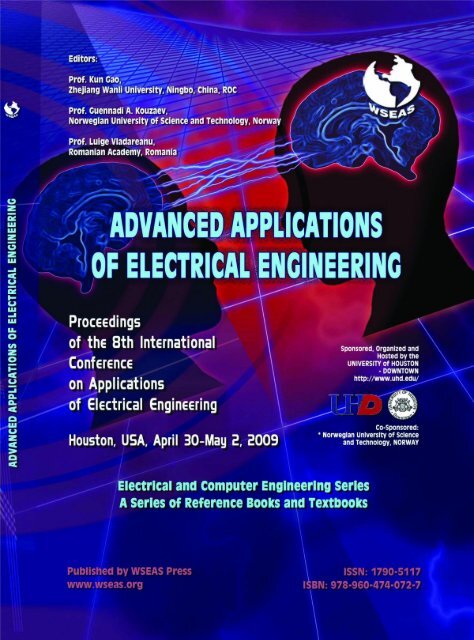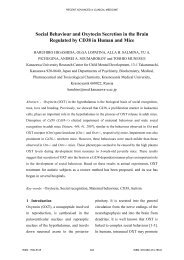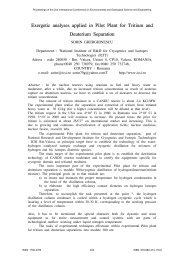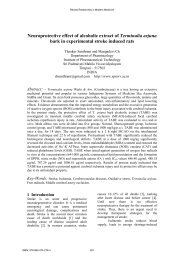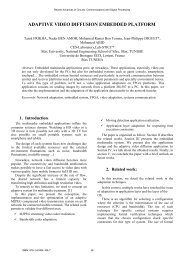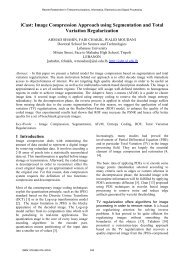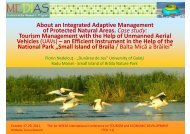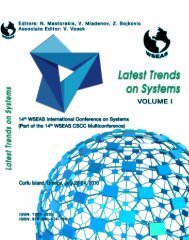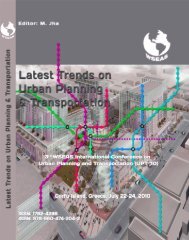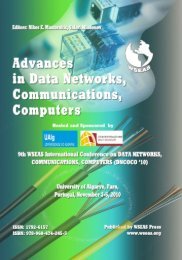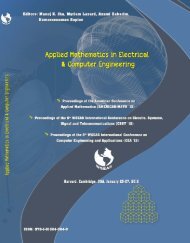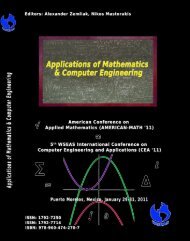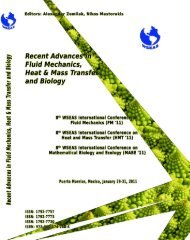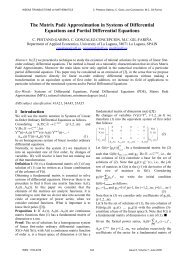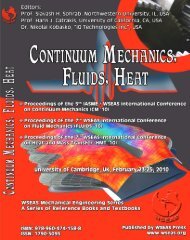Contents - Wseas.us
Contents - Wseas.us
Contents - Wseas.us
You also want an ePaper? Increase the reach of your titles
YUMPU automatically turns print PDFs into web optimized ePapers that Google loves.
ADVANCED APPLICATIONS OF<br />
ELECTRICAL ENGINEERING<br />
Proceedings of the 8th International Conference on Applications of<br />
Electrical Engineering (AEE ’09)<br />
Proceedings of the 8th International Conference on Applied<br />
Electromagnetics, Wireless and Optical Communications<br />
(ELECTRO ‘09)<br />
Ho<strong>us</strong>ton, USA<br />
April 30-May 2, 2009<br />
Sponsored, Organized and Hosted by the<br />
UNIVERSITY of HOUSTON - DOWNTOWN<br />
http://www.uhd.edu/<br />
Co-Sponsored:<br />
Norwegian University of Science and Technology, NORWAY<br />
Recent Advances in Electrical Engineering<br />
A Series of Reference Books and Textbooks<br />
Published by WSEAS Press ISSN: 1790-5117<br />
www.wseas.org ISBN: 978-960-474-072-7
ADVANCED APPLICATIONS OF<br />
ELECTRICAL ENGINEERING<br />
Proceedings of the 8th International Conference on Applications of<br />
Electrical Engineering (AEE ’09)<br />
Proceedings of the 8th International Conference on Applied<br />
Electromagnetics, Wireless and Optical Communications<br />
(ELECTRO ‘09)<br />
Ho<strong>us</strong>ton, USA<br />
April 30-May 2, 2009<br />
Recent Advances in Electrical Engineering<br />
A Series of Reference Books and Textbooks<br />
Published by WSEAS Press<br />
www.wseas.org<br />
Copyright © 2009, by WSEAS Press<br />
All the copyright of the present book belongs to the World Scientific and Engineering Academy and<br />
Society Press. All rights reserved. No part of this publication may be reproduced, stored in a retrieval<br />
system, or transmitted in any form or by any means, electronic, mechanical, photocopying, recording, or<br />
otherwise, without the prior written permission of the Editor of World Scientific and Engineering Academy<br />
and Society Press.<br />
All papers of the present volume were peer reviewed by two independent reviewers. Acceptance was<br />
granted when both reviewers' recommendations were positive.<br />
See also: http://www.worldses.org/review/index.html<br />
ISSN: 1790-5117<br />
ISBN: 978-960-474-072-7<br />
World Scientific and Engineering Academy and Society
ADVANCED APPLICATIONS OF<br />
ELECTRICAL ENGINEERING<br />
Proceedings of the 8th International Conference on Applications of<br />
Electrical Engineering (AEE ’09)<br />
Proceedings of the 8th International Conference on Applied<br />
Electromagnetics, Wireless and Optical Communications<br />
(ELECTRO ‘09)<br />
Ho<strong>us</strong>ton, USA<br />
April 30-May 2, 2009
Editors:<br />
Prof. Vasilis Zafiris, University of Ho<strong>us</strong>ton-Downtown, Ho<strong>us</strong>ton, USA<br />
Prof. Maria Benavides, University of Ho<strong>us</strong>ton-Downtown, Ho<strong>us</strong>ton, USA<br />
Prof. Kun Gao, Zhejiang Wanli University, Ningbo, China, ROC<br />
Prof. Shohreh Hashemi, University of Ho<strong>us</strong>ton-Downtown, Ho<strong>us</strong>ton, USA<br />
Prof. Katarina Jegdic, University of Ho<strong>us</strong>ton-Downtown, Ho<strong>us</strong>ton, USA<br />
Prof. Guennadi A. Kouzaev, Norwegian University of Science and Technology, Norway<br />
Prof. Plamen Simeonov, University of Ho<strong>us</strong>ton-Downtown, Ho<strong>us</strong>ton, USA<br />
Prof. Luige Vladareanu, Romanian Academy, Romania<br />
Prof. Carol Vobach, University of Ho<strong>us</strong>ton-Downtown, Ho<strong>us</strong>ton, USA<br />
International Program Committee Members:<br />
John Tsitsiklis, USA<br />
Irwin W. Sandberg, USA<br />
Lotfi A. Zadeh, USA<br />
Viola Vogel, Switzerland<br />
Dimitris Bertsekas, USA<br />
Lena Valavani, USA<br />
Leonid G. Kazovsky, USA<br />
Leon O. Chua, USA<br />
Brian A. Barsky, USA<br />
K. R. Rao, USA<br />
Bimal K. Bose, USA<br />
Joseph Sifakis, France<br />
Paul E. Dimotakis, USA<br />
Sidney Burr<strong>us</strong>, USA<br />
Biswa Nath Datta, USA<br />
George Giannakis, USA<br />
Nikolaos Bourbakis, USA<br />
Nikos E. Mastorakis, Bulgaria<br />
Yorgo Istefanopulos, Turkey<br />
George E Andrews, USA<br />
Stuart S. Antman, USA<br />
Soren H. Morup, Denmark<br />
Robert A. Kosinski, Poland<br />
Ivan L'Heureux, Canada<br />
Alexander G.Ramm, USA<br />
Steven Collicott, USA<br />
Wilfried B. Kraetzig, Germany<br />
Panos Pardalos, USA<br />
Ronald Yager, USA<br />
Stamatios Kartalopoulos, USA<br />
Kleanthis Psarris, USA<br />
Borje Forssell, Norway<br />
Metin Demiralp, Turkey<br />
Constantin Udriste, Romania<br />
Amauri Caballero, USA<br />
Geir Oien, Norway<br />
George Vachtsevanos, USA<br />
Spyros Tragoudas, USA<br />
Olga Martin, Romania<br />
Demetrios Kazakos, USA<br />
Gamal Elnagar, USA<br />
Periklis Papadopoulos, USA
Preface<br />
This year the 8th WSEAS International Conference on Applications of Electrical Engineering<br />
(AEE ’09) and the 7th International Conference on Applied Electromagnetics, Wireless and<br />
Optical Communications (ELECTRO '09) were held in Ho<strong>us</strong>ton, USA. The Conference remains<br />
faithful to its original idea of providing a platform to disc<strong>us</strong>s theoretical and applicative aspects<br />
of applications of circuits, systems, electronics, applications of control and robotics, applications<br />
of power systems, applications of communications etc. with participants from all over the world,<br />
both from academia and from ind<strong>us</strong>try.<br />
Its success is reflected in the papers received, with participants coming from several countries,<br />
allowing a real multinational multicultural exchange of experiences and ideas.<br />
The accepted papers of this conference are published in this Book that will be indexed by ISI.<br />
Please, check it: www.worldses.org/indexes as well as in the CD-ROM Proceedings. They will<br />
be also available in the E-Library of the WSEAS. The best papers will be also promoted in many<br />
Journals for further evaluation.<br />
A Conference such as this can only succeed as a team effort, so the Editors want to thank the<br />
International Scientific Committee and the Reviewers for their excellent work in reviewing the<br />
papers as well as their invaluable input and advice.<br />
The Editors
ADVANCED APPLICATIONS OF ELECTRICAL ENGINEERING<br />
Table of <strong>Contents</strong><br />
Keynote Lecture 1: Four Open Mathematical Problems Related to Computer Graphics and<br />
Geometric Modeling<br />
Ron Goldman<br />
11<br />
Keynote Lecture 2: Cardiovascular Informatics: How to Stop a Heart Attack Before it Happens 12<br />
Ioannis A. Kakadiaris<br />
Keynote Lecture 3: Compilation and Optimization for High Performance Computing 13<br />
Kleanthis Psarris<br />
Keynote Lecture 4: If It's Fast It M<strong>us</strong>t Be Newton's Method 14<br />
Richard Tapia<br />
Keynote Lecture 5: Geometric Analysis of SL(2,C) and Biologically-Mediated Computational<br />
Vision<br />
Jacek Turski<br />
15<br />
Plenary Lecture 1: Topological Electromagnetics and its Applications 16<br />
Guennadi A. Kouzaev<br />
Plenary Lecture 2: Nanotechnology Research Advances in Mexico 17<br />
Armando Barranon<br />
Plenary Lecture 3: The Real Time Control of Modular Walking Robot Stability 18<br />
Luige Vladareanu<br />
Virtual Simulation of Soft Tissue Deformation <strong>us</strong>ing Bulk Variables 19<br />
K. Sundaraj<br />
Biceps Activity EMG Pattern Recognition <strong>us</strong>ing Neural Networks 25<br />
K. Sundaraj<br />
An Investigative Model for Illegal VoIP B<strong>us</strong>iness Operator 30<br />
A. Fuad Md. Bandi, Norazrina Abu Haris, Abd. Razif Tamrin, Azmirul Hamzah Nor Hamzah, Hermiewan<br />
Hamdan, Suriah Hasan, Sahirman Abdullah, Md. Daud Jaafar, Md. Azmi Karnain, Mazlan Burhanudin<br />
Fixed Complexity Sphere Decoding for Spatial Multiplexing MIMO 35<br />
M. Haridim, V. Neder, D. Ezri, H. Matzner<br />
Development of a Software Tool for Performance Evaluation of MIMO OFDM Alamouti <strong>us</strong>ing a<br />
didactical Approach as a Educational and Research support in Wireless Communications<br />
Jose Cordova, Rebeca Estrada<br />
41<br />
Wrinkle Assesment of the Fabric <strong>us</strong>ing Image Processing 48<br />
Seyed Abbas Mirjalili, Esfandiyar Ekhtiyari<br />
SMS or E-mail Alert System for Centralize Mail Compartment 52<br />
S. K. Subramaniam, S. H. H<strong>us</strong>in, Y. Y<strong>us</strong>op, A. H. Hamidon<br />
Comparison of Fuzzy Bk-Product and A* Search Algorithm for Optimal Path Finding in<br />
Unsupervised Underwater Environment<br />
Arif Reza Anwary<br />
57<br />
ISSN: 1790-5117 7 ISBN: 978-960-474-072-7
ADVANCED APPLICATIONS OF ELECTRICAL ENGINEERING<br />
Mobile University Notification System: A Jabber-based Notification System for Educational<br />
Institutions<br />
Mohd Hilmi Hasan, Emy Elyanee M<strong>us</strong>tapha, Halif Rizuan Baharuddin<br />
Global Model of Intelligence and Memorizing of Information from Conception until a Child<br />
Starts to Walk for the Period from 2009 until 2020<br />
Vinko Viducic, Damir Boras, Ljiljana Viducic<br />
64<br />
70<br />
Using Self-Organizing Neural Network for Image Mosaicing 76<br />
Shipra Sharma, Hitesh Tuli, Shivam Nagar, Tanuj Dhir, Sumit Tayal<br />
Voltage Stability Enhancement of Low Voltage Distribution Feeder <strong>us</strong>ing Static Var<br />
Compensator: A Case Study<br />
K. B. Porate, K. L. Thakre, G. L. Bodhe<br />
81<br />
Self Checking and Fault Tolerant Digital Design 86<br />
Y. Rajasree, Y. Vishnu Priya, N. R. Alamelu<br />
Design and Performance of a Tactile Device for Haptic Shape Perception 93<br />
Sukhwinder Singh<br />
AC-Impedance of an Undoped Lead Iodide Single Crystal Prepared from Polycrystalline Ingot<br />
Synthesized with 10% Excess of Iodine<br />
Mo<strong>us</strong>a M. Abdul-Gader Jafar, Mahmoud A. Hassan, Ibrahim F. Al-Hamarneh, Marie Matuchova<br />
98<br />
Control of Binary Distillation Column <strong>us</strong>ing Fuzzy PI Controllers 103<br />
Shahram Javadi, Jabber Hosseini<br />
Multilingual Mobile Translation and Query System 111<br />
Mo<strong>us</strong>sa Abdallah, Ata Alqadi, Ahmad Saleh, Waleed Khamis<br />
Static Synchrono<strong>us</strong> Compensator to Regulate Voltage Profile and Increase Power System<br />
Security<br />
Isuf Krasniqi, Arber Percuku<br />
117<br />
Rob<strong>us</strong>t Performance Characterization of PID Controllers in the Frequency Domain 121<br />
Tooran Emami, John M. Watkins<br />
Comparetive Study of the Results Obtained from DGA of Transformer Oil with the Help of<br />
Different Models of Grey Theory and their Application in Fault Diagnosis<br />
Anjali Chatterjee, Nirmal Kumar Roy<br />
128<br />
A Unified Approach for Sensitivity Design of PID Controllers in the Frequency Domain 135<br />
Tooran Emami, John M. Watkins<br />
New Model of MERO Modular Walking Robots Support for Heavy Load Transportation 141<br />
Ion Ion, Luige Vladareanu, Curaj Adrian, Aurelian Vasile<br />
Sensitivity Analysis of Interconnected Power System Low Frequency Oscillation 147<br />
Huijie Shi, Chen Chen, Yong Jin<br />
Dynamics of Transitions in Reliability Analysis of Complex Multi-State Systems 153<br />
Gabriela Tont<br />
ISSN: 1790-5117 8 ISBN: 978-960-474-072-7
ADVANCED APPLICATIONS OF ELECTRICAL ENGINEERING<br />
Automatic Cardiac Motion Quantification by Extracting Landmarks from an Echocardiography<br />
Sequence<br />
Meysam Siyah Mansoory, Hamid Behnam, Emad Fatemizadeh<br />
159<br />
Smart Discrete Sensor Array for Fault Diagnostics of Rotating Machinery 166<br />
Z. Mahmood, N. Lehrasab, N. S. Khattak<br />
Finite Element Analysis of Quasistatic Frictional Contact Problems with an Incremental-<br />
Iterative Algorithm<br />
Nicolae Pop, Luige Vladareanu, Petrica Pop<br />
173<br />
The Real Time Control of Modular Walking Robot Stability 179<br />
Luige Vladareanu, Ion Ion, Lucian M. Velea, Daniel Mitroi, Alexandru Gal<br />
An OFDM Based Solution for Wireless Control of Serpentine Robot Employed in a Mobile<br />
Adhoc Network (MANET)<br />
R. P. Chatterjee, B. Sutradhar, Uma Dutta<br />
187<br />
Basics of Topological Electromagnetics and its Applications 195<br />
Guennadi Kouzaev<br />
Predicate and Binary Operations Processor 199<br />
A. N. Kostadinov, G. A. Kouzaev<br />
A Method of Autonomo<strong>us</strong> Blocks Partially Filled by Nonlinear Gyromagnetic Media for<br />
Nanoelectromagnetic Applications<br />
G. S. Makeeva, O. A. Golovanov, M. Pardavi-Horvath, G. A. Kouzaev<br />
Electronics Properties of Nanosized CeO2 Synthesized via a Hydrothermal Process and their<br />
Influence on the Preparation of Au/CeO2 Catalysts, <strong>us</strong>ing Spectroscopic Techniques<br />
B. Acosta-Ruelas, R. Rangel, K. Rangel-Arreola, F. Castillon, E. Smolentseva, A. Simakov<br />
204<br />
208<br />
XAS Study of Silver Nanoparticles Formed in Phaseol<strong>us</strong> Vulgaris 211<br />
J. Parra Berumen, E. Gallegos-Loya, H. Esparza-Ponce, R. Gonzalez-Valenzuela, C. Gonzalez-Valenzuela, A.<br />
Duarte-Moller<br />
Computational Study of Multiplicity Fluctuations in Heavy Ion Collisions 216<br />
Armando Barranon<br />
Study of Superparamagnetic Nanocomposites of High Density Polyethylene and Maghemite 219<br />
R. Ruiz-Moreno, A. I. Martinez, A. A. Lopez, A. Barranon<br />
Color Based Iterative Detection of the Face Vertical Axis 222<br />
Suren Khachatryan, Andre Gaspar<br />
Authors Index 228<br />
ISSN: 1790-5117 9 ISBN: 978-960-474-072-7
ADVANCED APPLICATIONS OF ELECTRICAL ENGINEERING<br />
ISSN: 1790-5117 10 ISBN: 978-960-474-072-7
ADVANCED APPLICATIONS OF ELECTRICAL ENGINEERING<br />
Keynote Lecture 1<br />
Four Open Mathematical Problems Related to Computer Graphics<br />
and Geometric Modeling<br />
Professor Ron Goldman<br />
Department of Computer Science<br />
Rice University<br />
Abstract: Four unsolved problems that originate from research in Computer Graphics and Geometric Modeling will<br />
be presented. The first problem involves understanding the notion oscillation for Bezier surfaces, the freeform<br />
polynomial surfaces most common in Computer Graphics and Geometric Modeling. The second problem concerns<br />
gnerating smooth (C2 ) surfaces via subdivision from triangular or quadrilateral meshes of arbitrary topology. The<br />
third problem is related to Bezier curves and univariate Bernstein polynomials, and concerns the combinatorics of<br />
symmetrizing multiaffine functions. The fourth and final problem pertains to fractals and asks if there is an<br />
algorithm to determine whether two arbitrary sets of contractive affine transformations generate the same fractal.<br />
Brief Biography of the Speaker: Ron Goldman is a Professor of Computer Science at Rice University in Ho<strong>us</strong>ton,<br />
Texas. Professor Goldman received his B.S. in Mathematics from the Massach<strong>us</strong>etts Institute of Technology in 1968<br />
and his M.A. and Ph.D. in Mathematics from Johns Hopkins University in 1973. He is an associate editor of Computer<br />
Aided Geometric Design. In 2002, he published a book on Pyramid Algorithms: A Dynamic Programming Approach to<br />
Curves and Surfaces for Geometric Modeling. Dr. Goldman’s current research interests lie in the mathematical<br />
representation, manipulation, and analysis of shape <strong>us</strong>ing computers. His work includes research in computer aided<br />
geometric design, solid modeling, computer graphics, and splines. He is particularly interested in algorithms for<br />
polynomial and piecewise polynomial curves and surfaces, and he is currently investigating applications of algebraic<br />
and differential geometry to geometric modeling. He has published over a hundred articles in journals, books, and<br />
conference proceedings on these and related topics. Before returning to academia, Dr. Goldman worked for ten years<br />
in ind<strong>us</strong>try solving problems in computer graphics, geometric modeling, and computer aided design. He served as a<br />
Mathematician at Manufacturing Data Systems Inc., where he helped to implement one of the first ind<strong>us</strong>trial solid<br />
modeling systems. Later he worked as a Senior Design Engineer at Ford Motor Company, enhancing the capabilities<br />
of their corporate graphics and computer aided design software. From Ford he moved on to Control Data<br />
Corporation, where he was a Principal Consultant for the development group devoted to computer aided design and<br />
manufacture. His responsibilities included data base design, algorithms, education, acquisitions, and research. Dr.<br />
Goldman left Control Data Corporation in 1987 to become an Associate Professor of Computer Science at the<br />
University of Waterloo in Ontario, Canada. He joined the faculty at Rice University in Ho<strong>us</strong>ton, Texas as a Professor<br />
of Computer Science in July 1990.<br />
ISSN: 1790-5117 11 ISBN: 978-960-474-072-7
ADVANCED APPLICATIONS OF ELECTRICAL ENGINEERING<br />
Keynote Lecture 2<br />
Cardiovascular Informatics: How to Stop a Heart Attack Before it Happens<br />
Professor Ioannis A. Kakadiaris<br />
Computational Biomedicine Lab Depts. of CS, ECE<br />
Biomedical Engineering, University of Ho<strong>us</strong>ton<br />
Abstract: In this talk, first I will offer a short overview of the research activities of the Computational Biomedicine<br />
Laboratory, University of Ho<strong>us</strong>ton. Then, I will present our research in the area of biomedical image computing for<br />
the mining of information from cardiovascular imaging data for the detection of persons with a high likelihood of<br />
developing a heart attack in the near future (vulnerable patients). Specifically, I’ll present methods for detection and<br />
segmentation of anatomical structures, and shape and motion estimation of dynamic organs. The left ventricle in<br />
non-invasive cardiac MRI data is extracted <strong>us</strong>ing a novel multi-class, multi-feature fuzzy connectedness method and<br />
deformable models for shape and volume estimation. In non-invasive cardiac CT data, the thoracic fat is detected<br />
<strong>us</strong>ing a relaxed version of multi-class, multi-feature fuzzy connectedness method. Additionally, the calcified lesions<br />
in the coronary arteries are also identified and quantified <strong>us</strong>ing a novel hierarchical supervised learning framework<br />
from the CT data. In non-invasive contrast-enhanced CT, the coronary arteries are detected <strong>us</strong>ing our novel tubular<br />
shape detection method for motion estimation and possibly, for non-calcified lesion detection. In invasive IVUS<br />
imaging, our team has developed a unique IVUS acquisition protocol and novel signal/image analysis methods) for<br />
the detection (for the first time in?vivo) of ‘vasa vasorum’ (VV). The VV are micro-vessels that are commonly<br />
present to feed the walls of larger vessels; however, recent clinical evidence has uncovered their tendency to<br />
proliferate around areas of inflammation, including the inflammation associated with vulnerable plaques. In<br />
summary, our work is foc<strong>us</strong>ed on developing novel computational tools to mine quantitative parameters from the<br />
imaging data for early detection of asymptomatic cardiovascular patient. The expected impact of our work stems<br />
from the fact that sudden heart attack remains the number one ca<strong>us</strong>e of death in the US, and unpredicted heart<br />
attacks account for the majority of the $280 billion burden of cardiovascular diseases.<br />
Brief Biography of the Speaker: Prof. Ioannis A. Kakadiaris is an Eckhard Pfeiffer Professor of Computer Science,<br />
Electrical & Computer Engineering, and Biomedical Engineering at the University of Ho<strong>us</strong>ton. He joined UH in Aug<strong>us</strong>t<br />
1997 after a postdoctoral fellowship at the University of Pennsylvania. Ioannis earned his B.Sc. in physics at the<br />
University of Athens in Greece, his M.Sc. in computer science from Northeastern University and his Ph. D. at the<br />
University of Pennsylvania. He is the founder of the Computational Biomedicine Lab (www.cbl.uh.edu) and this year<br />
directs the Methodist-University of Ho<strong>us</strong>ton-Weill Cornell Medical College Institute for Biomedical Imaging Sciences<br />
(IBIS) (ibis.uh.edu). His research interests include cardiovascular informatics, biomedical image analysis, biometrics,<br />
computer vision, and pattern recognition. Dr. Kakadiaris is the recipient of a number of awards, including the NSF<br />
Early Career Development Award, Schlumberger Technical Foundation Award, UH Computer Science Research<br />
Excellence Award, UH Enron Teaching Excellence Award, and the James Muller Vulnerable Plague Young<br />
Investigator Price. His research has been featured on Discovery Channel, National Public Radio, KPRC NBC News,<br />
KTRH ABC News, and KHOU CBS News.<br />
ISSN: 1790-5117 12 ISBN: 978-960-474-072-7
ADVANCED APPLICATIONS OF ELECTRICAL ENGINEERING<br />
Keynote Lecture 3<br />
Compilation and Optimization for High Performance Computing<br />
Professor Kleanthis Psarris<br />
Department of Computer Science<br />
The University of Texas at San Antonio<br />
San Antonio, TX 78249<br />
USA<br />
Abstract: High end parallel and multi-core processors rely on compilers to perform the necessary optimizations and<br />
exploit concurrency in order to achieve higher performance. However, source code for high performance computers<br />
is extremely complex to analyze and optimize. In particular, program analysis techniques often do not take into<br />
account complex expressions during the data dependence analysis phase. Most data dependence tests are only able<br />
to analyze linear expressions, even though non-linear expressions occur very often in practice. Therefore,<br />
considerable amounts of potential parallelism remain unexploited. In this talk we propose new data dependence<br />
analysis techniques to handle such complex instances of the dependence problem and increase program<br />
parallelization. Our method is based on a set of polynomial time techniques that can prove or disprove dependences<br />
in source codes with non-linear and symbolic expressions, complex loop bounds, arrays with coupled subscripts, and<br />
if-statement constraints. In addition our algorithm can produce accurate and complete direction vector information,<br />
enabling the compiler to apply further transformations. To validate our method we performed an experimental<br />
evaluation and comparison against the I-Test, the Omega test and the Range test in the Perfect and SPEC<br />
benchmarks. The experimental results indicate that our dependence analysis tool is accurate, efficient and more<br />
effective in program parallelization than the other dependence tests. The improved parallelization results into higher<br />
speedups and better program execution performance in several benchmarks.<br />
Brief Biography of the Speaker: Kleanthis Psarris is Professor and Chair of the Department of Computer Science at<br />
the University of Texas at San Antonio. His research interests are in the areas of Parallel and Distributed Systems,<br />
Compilers and Programming Languages. He received his B.S. degree in Mathematics from the National University of<br />
Athens, Greece in 1984. He received his M.S. degree in Computer Science in 1987, his M.Eng. degree in Electrical<br />
Engineering in 1989 and his Ph.D. degree in Computer Science in 1991, all from Stevens Institute of Technology in<br />
Hoboken, New Jersey. He has published extensively in top journals and conferences in the field and his research has<br />
been funded by the National Science Foundation and Department of Defense agencies. He is an Editor of the Parallel<br />
Computing journal. He has served on the Program Committees of several international conferences including the<br />
ACM International Conference on Supercomputing (ICS) in 1995, 2000, 2006 and 2008, the IEEE International<br />
Conference on High Performance Computing and Communications (HPCC) in 2008 and 2009, and the ACM<br />
Symposium on Applied Computing (SAC) in 2003, 2004, 2005 and 2006.<br />
ISSN: 1790-5117 13 ISBN: 978-960-474-072-7
ADVANCED APPLICATIONS OF ELECTRICAL ENGINEERING<br />
Keynote Lecture 4<br />
If It's Fast It M<strong>us</strong>t Be Newton's Method<br />
Professor Richard Tapia<br />
Computational & Applied Mathematics Department<br />
Rice University<br />
Ho<strong>us</strong>ton, TX<br />
USA<br />
Abstract: Shifted inverse and Rayleigh quotient iteration are well-known algorithms for computing an eigenvector<br />
of a symmetric matrix. In this talk we demonstrate that each of these algorithms can be viewed as a standard form of<br />
Newton's method from the nonlinear programming literature. This provides an explanation for their good behavior<br />
despite the need to solve systems with nearly singular coefficient matrices. Our equivalence result also leads <strong>us</strong><br />
naturally to a new proof that the convergence of the Rayleigh quotient iteration is q-cubic with rate constant at worst<br />
1.<br />
Brief Biography of the Speaker: Dr. Tapia is a mathematician and professor in the Department of Computational<br />
and Applied Mathematics at Rice University in Ho<strong>us</strong>ton, Texas. He is internationally known for his research in the<br />
computational and mathematical sciences and is a national leader in education and outreach. His current Rice<br />
positions are University Professor, Maxfield Oshman Professor in Engineering, Associate Director of Graduate<br />
Studies, and Director of the Center for Excellence and Equity in Education. Among his many honors, he was the first<br />
Hispanic elected to the National Academy of Engineering. In 1996 President Clinton appointed him to the National<br />
Science Board. From 2001 to 2004 he chaired the National Research Council's Board on Higher Education and the<br />
Workforce. He has received the National Science Foundation's inaugural Presidential Award for Excellence in<br />
Science, Mathematics, and Engineering Mentoring; and the Lifetime Mentor Award from the American Association for<br />
the Advancement of Science. He was also named one of 20 most influential leaders in minority math education by the<br />
National Research Council. Currently, his NSF-supported programs, Alliances for Graduate Education in the<br />
Professoriate, and the Empowering Leadership Alliance have developed supportive communities of students and<br />
faculty members that ensure the success of underrepresented individuals in STEM fields at U.S. institutions of higher<br />
learning. Professor Tapia is recognized as a national leader in diversity and has delivered numero<strong>us</strong> invited<br />
addresses at national and international mathematics conferences, served on university diversity committees, and<br />
provided leadership at a national level.<br />
ISSN: 1790-5117 14 ISBN: 978-960-474-072-7
ADVANCED APPLICATIONS OF ELECTRICAL ENGINEERING<br />
Keynote Lecture 5<br />
Geometric Analysis of SL(2,C) and Biologically-Mediated Computational Vision<br />
Professor Jacek Turski<br />
University of Ho<strong>us</strong>ton-Downtown<br />
Department of Computer and Mathematical Sciences<br />
USA<br />
Abstract: The group SL(2,C) of 2x2 complex matrices of determinant one occupies a truly remarkable place in<br />
mathematics and sciences. For example, it is inherently relevant to non-Euclidean geometries, modern complex<br />
analysis, and Einstein’s special theory of relativity. In our work, SL(2,C) provides unified geometrical and<br />
numerical framework for computational vision, including visual neuroscience and machine vision systems.<br />
The conformal camera, which models eyes imaging functions, produces image projective transformations generated<br />
by the linear-fractional mappings of the group SL(2,C). Th<strong>us</strong>, the camera's underlying geometry can be dually<br />
described as (1) one-dimensional complex projective geometry and (2) the conformal geometry imposed by the<br />
holomorphic complex structure of the Riemann sphere, also called Mobi<strong>us</strong>, or inversive geometry. Although this<br />
geometry does not possess a distance, it provides a full set of descriptors for the Gestalt rules <strong>us</strong>ed in grouping<br />
fragmented contours into global shapes that primate visual system m<strong>us</strong>t solve when viewing natural images—one of<br />
the most difficult problems to model numerically. The unity of geometrical and numerical methods is established by<br />
the fact that the conformal camera has its own projective Fourier analysis, geometric Fourier analysis constructed on<br />
the group SL(2,C) in the framework of representation theory of semisimple Lie groups—a great achievement of the<br />
20th century mathematics. Projective Fourier transform (PFT) provides image representation well adapted to both<br />
perspective transformations of retinal images and the retinotopy of the brain’s visual and oculomotor pathways.<br />
Th<strong>us</strong>, PFT integrates the head, eyes, and visual cortex into one computational system. We <strong>us</strong>e this binocular system<br />
to process visual information during fast scanning eye movements called saccades, employed to build up<br />
understanding of scenes despite the acuity limitations of foveate vision. We make about three saccades per second at<br />
the eyeball's maximum speed of 700 deg/sec. Visual sensitivity is markedly reduced, as we do not see moving<br />
retinal images. Despite these incisive eye movements, the fragmented pieces of visual information are integrated in<br />
the brain into a stable percept of the world. This visual constancy is maintained by neuronal receptive field shifts<br />
prior to saccade onset in vario<strong>us</strong> retinotopically organized cortical areas. These shifts give the brain access to visual<br />
information at the impending saccade target prior to the eyes’ arrival. It integrates visual information across<br />
saccades and eliminates the need for starting visual information acquisition anew three times per second at each<br />
fixation. However this remapping is not perfect; around the time of saccades, the flashed probes are not perceived in<br />
veridical locations by humans in laboratory experiments, a phenomenon called perisaccadic mislocalization.<br />
In our modeling of perisaccadic perception, we utilize basic properties of PFT. First, the PFT can be efficiently<br />
computed by a fast Fourier transform in logarithmic coordinates that approximate the retinotopy. Second, a simple<br />
translation in retinotopic (logarithmic) coordinates, modeled by the standard shift property of Fourier transform,<br />
remaps the presaccadic scene into a postsaccadic reference frame. This shift also accounts for the perisaccadic<br />
mislocalization.<br />
This research program is guided by a strategy important in the contemporary neurocomputing research: linking<br />
known anatomical and physiological details with efficient computational modeling should be vital not only to<br />
emerging field of neural engineering but also to interpreting relevant neurophysiological data.<br />
Brief Biography of the Speaker: Jacek Turski was awarded his Ph.D. from McGill University. After holding<br />
postdoctoral positions at the University of Manitoba and the University of Ho<strong>us</strong>ton, he joined the University of<br />
Ho<strong>us</strong>ton-Downtown where he is now a full professor in the Department of Computer and Mathematical Sciences.<br />
Five years ago Turski constructed projective Fourier analysis of the conformal camera in the framework of the<br />
representation theory of semisimple Lie groups. Based on this Fourier analysis, he is currently developing a<br />
physiologically realistic model of human and robotic vision systems. His research has been supported by the NSF<br />
grants. He was the recipient of the 2006 Scholarship/Creativity Award at UHD.<br />
ISSN: 1790-5117 15 ISBN: 978-960-474-072-7
ADVANCED APPLICATIONS OF ELECTRICAL ENGINEERING<br />
Plenary Lecture 1<br />
Topological Electromagnetics and its Applications<br />
Professor Guennadi A. Kouzaev<br />
Norwegian University of Science and Technology<br />
NORWAY<br />
Abstract: Topological electromagnetics is the theory which studies the global spatiotemporal features of the<br />
electromagnetic field. It is dealing with the topological analysis of the electromagnetic field and with the qualitative<br />
solutions of boundary electromagnetic problems.<br />
In this lecture, the basics of topological electromagnetism are introduced. The definition of the electromagnetic field<br />
topological schemes which are composed of the equilibrium points and separatrices of the field-force line portraits is<br />
given, and the Maxwell-like equations are introduced for topologies of the electric and magnetic fields.<br />
The treatment of the boundary problems of the electromagnetism is considered. It consists of analytical or semianalytical<br />
composition of the topological field schemes according to the field boundary graphs. The developed field<br />
computing approach is fast and, and it is for the effective initial solutions of boundary electromagnetic problems.<br />
This theory is applied to the electromagnetic signaling and computing. The carrier of digital information is the<br />
spatio-time topology of electromagnetic impulses, and the digital processing of them can be realized even by passive<br />
circuits. This approach is applied to the modeling of the Boolean, predicate, reconfigurable, and pseudo-quantum<br />
logics. The brain pattern activity is proposed to be modeled by these signals, and a quasi-neural gate of the OR/AND<br />
type is modeled. The gates of one of the types are integrated into a topological processor for predicates, and its<br />
design and work are considered shortly in this lecture.<br />
Brief Biography of the Speaker: The speaker is a Professor at the Norwegian University of Science and<br />
Technology-NTNU, Trondheim, Norway. He received the Dr. Sciences (Habil.) degree from the Moscow State<br />
Institute of Electronics and Mathematics (Techn. University) in Computer Engineering and Microwave Electronics, in<br />
1998. He was with the R<strong>us</strong>sia Research Institute of Space Instrument Design, Moscow State Institute of Electronics<br />
and Mathematics, Gennum Corp. and McMaster University (Canada).<br />
He has published more than 100 publications and 14 inventions for topological electromagnetism, topologically<br />
modulated signals and computing, microwave and high-speed three-dimensional and planar integrated circuits,<br />
physics of cold matter, and micro -and millimeter-wave biomonitoring.<br />
Prof. G. Kouzaev was awarded with the R<strong>us</strong>sian Government Prize (1997) and the Soviet Union Prize for Young<br />
Scientists (1990) for his achievements in three-dimensional integration and space-time signal processing hardware<br />
for airspace applications.<br />
He is a Member of the IEEE, WSEAS, IMAPS, and Trans Black Sea Region Science Union for Applied<br />
Electromagnetics. Dr. G.A. Kouzaev is a Chair of several WSEAS conferences and a track-chair of the IEEE<br />
supported conferences. He was a Co-chair of a SPIE symposium on terahertz electronics and a Program Committee<br />
Member of several international meetings on applied electromagnetics, wave physics and computer engineering.<br />
ISSN: 1790-5117 16 ISBN: 978-960-474-072-7
ADVANCED APPLICATIONS OF ELECTRICAL ENGINEERING<br />
Plenary Lecture 2<br />
Nanotechnology Research Advances in Mexico<br />
Professor Armando Barranon<br />
Department of Basic Sciences,<br />
Universidad Autonoma Metropolitana-Azcapotzalco, Mexico City<br />
MEXICO<br />
Abstract: Nanotechnology research groups in Mexico typically have five members and are devoted to a wide range<br />
of research subjects. Nanotechnology Laboratories have been founded in several Mexican States, <strong>us</strong>ing<br />
computational techniques, nanomicroscopy and chemical synthesis to develop new materials as well as new<br />
theoretical approaches to understand nanotechnology properties. Other Mexican nanotechnology research groups<br />
study the social and environmental impact of nanotechnology. The size frequency distribution of these research<br />
groups follows a power law in agreement with a model for social interaction although there are no signs of an<br />
institutional organization of these research groups which might lead to the creation of a Mexican Nanotechnology<br />
Initiative. Nevertheless, by 2006 Mexican Council of Science of Technology funded several research groups to<br />
develop projects related to a Mexican National Initiative. In this plenary talk I will describe the research activities of<br />
about fifty Mexican nanotechnology research groups, comprising 300 researchers, and I will explain the need for<br />
governmental intervention in order to attain the objective of a Mexican Nanotechnology Initiative.<br />
Brief Biography of the Speaker: Armando Barranon was born in Mexico City. B.Sc. in Mathematical Physics,<br />
Instituto Politecnico Nacional, Mexico City, 1986. M.Sc. in Applied Statistics, The University of Texas at El Paso,<br />
1989. Dr. in Philosophy, U. La Salle, Magna Cum Laude, Mexico City, 2004. M.Sc. Physics, Instituto Politecnico<br />
Nacional, Mexico City, 2005. Dr. in Physics of Materials, Instituto Politecnico Nacional, Mexico City, 2008.<br />
Postdoctoral Fellow, U. Zacatecas, Mexico, 2008.<br />
He is Full Professor at Department of Basic Sciences, Universidad Autonoma Metropolitana-Azcapotzalco, Mexico<br />
City. Research interests include Nuclear Physics, Computational Physics and Philosophy of Technology. In 2007, Dr.<br />
Barranon founded the Nanoeducation Seminar at UAM-Azcapotzalco.<br />
Dr. Barranon is member of the Mexican National Research System, member of American Physical Society, Sociedad<br />
Mexicana de Fisica, Sociedad Mexicana de Matematicas, Sociedad Mexicana de Termodinamica, Sociedad<br />
Mexicana de Historia de la Ciencia y la Tecnologia, among others.<br />
ISSN: 1790-5117 17 ISBN: 978-960-474-072-7
ADVANCED APPLICATIONS OF ELECTRICAL ENGINEERING<br />
Plenary Lecture 3<br />
The Real Time Control of Modular Walking Robot Stability<br />
Professor Luige Vladareanu<br />
Romanian Academy, Institute of Solid Mechanics, Bucharest<br />
ROMANIA<br />
Abstract: The paper presents an open architecture system for real time control of stability for modular walking<br />
robots with applications in the MERO structured walking robots. Starting with direct and inverted kinematic<br />
modelling of the movement of walking robots, determining the mathematical equations in Cartesian coordinates for<br />
the support point Pi, found at the extremity of the leg i, in relation to the system attached to the platform and through<br />
quasi-dynamic analysis of the mathematical modelling for defining the walking type, the speed and the direction of<br />
movement, the robot’s stability control algorithm has been deduced. For stability control an open architecture<br />
system has been developed which ensures a real time hybrid position-force control in which the position errors<br />
representation is given in relation to a squared Jacobean matrix of maximum rank, a selection matrix S and a<br />
pseudo-invert (SJ)+ of the SJ matrix. In force control, the force Cartesian error fe , is calculated as the difference<br />
between the actual and desired force. By <strong>us</strong>ing S+, which represents the orthogonal complement of S, the selected<br />
Cartesian force errors are determined and the robot/s transposed Jacobean matrix transforms Cartesian forces in<br />
torques corresponding to the joints. Using, in particular, the selected Cartesian force errors, the selected torque joints<br />
errors are obtained. This architecture is based on a series of associated projection matrixes which allow dividing a<br />
vector by transforming the matrix A, into two perpendicular components. Th<strong>us</strong> modifying the hybrid position-force<br />
control system ensures all the conditions for stability. Mainly this is due to the fact that calculation the inverted<br />
Jacobean matrix is no longer necessary, which <strong>us</strong>ed to provoke kinematics’ instability of the hybrid position-force<br />
control system. The obtained results have allowed the graphical determination of the walking robot model’s reply to<br />
round the coordinate axis rotation and have led to an improvement in the response time to disturbances and to<br />
following the movement trajectory in conditions of high stability.<br />
Brief Biography of the Speaker: Luige Vladareanu received his M.Sc. degree in electronics from the Polytechnic<br />
Institute Bucharest, in 1977. From 1984, scientific researcher of the Institute of Physics and Material Technology,<br />
from 1990, team leader of data acquisition systems and real time control systems of the Institute of Solid Mechanics,<br />
from 1991, President General Manager of Engineering and Technology Ind<strong>us</strong>trial VTC company. In 1998 he received<br />
Ph.D. degree in electronics field from the Institute of Solid Mechanics of Romanian Academy. From 2003, Ministry of<br />
Education and Research, executive Department for Financing Superior Education and of Scientific University<br />
Research - High Level Expert Consulting for MEC/CNCSIS project, from 2003-2005, member of Engineering Science<br />
Committee of Romanian National Research Council, from 2005, Scientific Researcher Gr.I (Professor) of Romanian<br />
Academy. His scientific work is foc<strong>us</strong>ed on real time control in solid mechanics applied in robot trajectory control,<br />
hybrid position – force control, multi-microprocessor systems for robot control, acquisition and processing of<br />
experimental physical data, experimental methods and signal processing, nano-micro manipulators, semi-active<br />
control of mechanical system vibrations, semi-active control of magnetorheological dissipaters systems, complex<br />
ind<strong>us</strong>trial automations with programmable logical controllers in distributed and decentralized structure. He has<br />
published 4 books, over 20 book chapters, 11 edited books, over 200 papers in journals, proceedings and<br />
conferences in the areas. Director and coordinator of 7 grants of national research – development programs in the<br />
last 5 years, 15 invention patents, developing 17 advanced work methods resulting from applicative research<br />
activities and more then 60 research projects. In 1985 the Central Institute of Physics Bucharest awarded his<br />
research team a prise for the first Romanian ind<strong>us</strong>trial painting robot. He is the winner of the two Prize and Gold of<br />
Excellence in Research 2000, SIR 2000, of the Romanian Government and the Agency for Science, Technology and<br />
Innovation. 3 International Invention and Innovation Competition Awards and Gold of World’s Exhibition of Inventions,<br />
Geneva 2007 and 2008, and other 7 International Invention Awards and Gold of the Br<strong>us</strong>sels, Croatia, Bucharest<br />
International Exhibition. He received “Traian Vuia” (2006) award of the Romanian Academy, Romania’s highest<br />
scientific research forum, for a group of scientific papers published in the real time control in the solid mechanics. He<br />
is a member of the International Institute of Aco<strong>us</strong>tics and Vibration (IIAV), Auburn University, USA (2006), ABI/s<br />
Research Board of Advisors, American Biographical Institute (2006), World Scientific and Engineering Academy<br />
Society, WSEAS (2005), International Association for Modelling and Simulation Techniques in Enterprises-AMSE,<br />
France (2004), National Research Council from Romania(2003-2005), etc.<br />
ISSN: 1790-5117 18 ISBN: 978-960-474-072-7
ADVANCED APPLICATIONS OF ELECTRICAL ENGINEERING<br />
Authors Index<br />
Abdallah, M. 111 Golovanov, O. 204 Nagar, S. 76<br />
Abdullah, S. 30 Gonzalez-Valenzuela, C. 211 Neder, V. 35<br />
Abu Haris, N. 30 Gonzalez-Valenzuela, P. 211 Pardavi-Horvath, M. 204<br />
Acosta-Ruelas, B. 208 Hamdan, H. 30 Parra Berumen, J. P. 211<br />
Adrian, C. 141 Hamidon, A. H. 52 Percuku, A. 117<br />
Alamelu, N. 86 Hamzah, A. H. 30 Pop, N. 173<br />
Al-Hamarneh, I. F. 98 Haridim, M. 35 Pop, P. 173<br />
Alqadi, A. 111 Hasan, M. 64 Porate, K. 81<br />
Anwary, A. R. 57 Hasan, S. 30 Rajasree, Y. 86<br />
Baharuddin, H. R. 64 Hassan, M. 98 Rangel, R. 208<br />
Bandi, A. F. 30 Hosseini, J. 103 Rangel-Arreola, K. 208<br />
Barranon, A. 219 H<strong>us</strong>in, S. 52 Roy, N. K. 128<br />
Barranon, A. 216 Ion, I. 141, 179 Ruiz-Moreno, R. 219<br />
Behnam, H. 159 Jafar, M. 98 Saleh, A. 111<br />
Bodhe, L. 81 Javadi, S. 103 Sharma, S. 76<br />
Boras, D. 70 Jin, Y. 147 Shi, H. 147<br />
Burhanudin, M. 30 Karnain, M. 30 Simakov, A. 208<br />
Castillon, F. 208 Khachatryan, S. 222 Singh, S. 93<br />
Chatterjee, A. 128 Khamis, W. 111 Smolentseva, E. 208<br />
Chatterjee, R. P. 187 Khattak, N. 166 Subramaniam, S. 52<br />
Chen, C. 147 Kostadinov, A. N. 199 Sundaraj, K. 19, 25<br />
Cordova, J. 41 Kouzaev, G. 199, 204 Sutradhar, B. 187<br />
Daud Jaafar, M. D. 30 Kouzaev, G. 195 Tamrin, A. R. 30<br />
Dhir, T. 76 Krasniqi, I. 117 Tayal, S. 76<br />
Duarte-Moller, A. 211 Lehrasab, N. 166 Thakre, K. 81<br />
Dutta, U. 187 Lopez, A. 219 Tont, G. 153<br />
Ekhtiyari, E. 48 Mahmood, Z. 166 Tuli, H. 76<br />
Emami, T. 121, 135 Makeeva, G. 204 Vasile, A. 141<br />
Esparza-Ponce, H. 211 Mansoory, M. 159 Velea, L. 179<br />
Estrada, R. 41 Martinez, A. I. 219 Viducic, L. 70<br />
Ezri, D. 35 Matuchova, M. 98 Viducic, V. 70<br />
Fatemizadeh, E. 159 Matzner, H. 35 Vishnu Priya, Y. 86<br />
Gal, A. 179 Mirjalili, S. 48 Vladareanu, L. 141, 173, 179<br />
Gallegos-Loya, E. 211 Mitroi, D. 179 Watkins, J. 121, 135<br />
Gaspar, A. 222 M<strong>us</strong>tapha, E. 64 Y<strong>us</strong>op, Y. 52<br />
ISSN: 1790-5117 228 ISBN: 978-960-474-072-7


